Social isolation is a necessary evil. However, even as quarantine becomes more important than ever to flattening the curve, a new crisis is appearing, directly caused by these necessary measures. Because while students became focused on stopping the physical spread of coronavirus, a new mental crisis was spreading. It’s an emerging crisis of stress, anxiety and worry, and one that students are unprepared to handle. We are seeing a mental health pandemic.
Last March, The Substance Abuse and Mental Health Services Administration reported that calls to an national emergency hotline, which provides help to those in emotional distress, increased by 891% compared to March of 2019. And in a recent study conducted by Harvard researchers in Italy, one of the epicenters of the pandemic, scientists found that anxiety levels, boredom and a “sense of hopelessness” all increased the longer the self-isolation measures were in action.
“Social isolation presents a spectrum of challenges, [like] being separated from your usual support systems and social activity, to someone not being able to attend sessions with their therapist or counselor if they have one,” AP Psychology teacher Donna Walker said. “There are too many factors to count that are affecting mental health these days in relation to the pandemic, and they all unfortunately interact with each other.”
Self-isolation poses an especially significant risk to students, who are being forced to face both the cancellations or postponements of various events such as prom and the removal of a structured school day.
According to the Guardian in late March, a UK poll found that 83% of students said their mental health had worsened since isolation began. A March report published in The Lancet, a leading medical journal, found that extended isolation had a pronounced effect on “emotional disturbance” in students, including “depression, stress, low mood, irritability, insomnia, post-traumatic stress symptoms, anger, and emotional exhaustion.”
Walker attributes these struggles to the loss of routine that comes with suddenly transitioning from a structured school day to an unfamiliar remote learning system. Without a routine, harmful habits might develop such as not getting enough sleep, spending too much time inside or not keeping a healthy diet.
“This is all very stressful as they work towards a new level of discipline and self-regulation to get work done, all while watching the terrifying news around us,” Walker said.
Walker also said that students are making a critical mistake regarding their environment in isolation.
“When I ‘see’ my students in Meets, some of them are always in a dark room,” Walker said. “Lack of sunlight can lead to all sorts of health issues, from messing up your Circadian rhythm to depleting serotonin levels, which can lead to depression.”
Walker also said that student athletes are some of the most sensitive to the mental health effects of isolation. This is because they not only have to deal with the cancellation of events they were likely preparing for for months, but also that, if they don’t keep up an exercise regimen, they can suffer the effects of massive adrenaline and endorphin drop-off.
All of these effects together can form what seems like an impossible situation, especially when various studies show that people with a history of mental health difficulties are much more likely to have their condition deteriorate during quarantine.
Fortunately, there are many things students can do to help cope with the challenges that isolation poses, most importantly by staying connected.
“We need more than ever to keep up our social connections, and fortunately we have technology that allows us to stay connected without being in physical proximity,” Walker said.
In addition, students need to keep a semblance of a routine, similar even to a school day. While online school provides some structure, students going further in disciplining their hygiene, sleep habits and daily schedule can help keep a sense of order or normalcy. A 2011 study published in the Journal of Abnormal Child Psychology found that steady routines, especially at home, are instrumental in moderating emotional distress and staying mentally healthy.
“Don’t go full vampire,” Walker said.
In addition, one of the most beneficial things students can do is also one of the simplest: go outside. Studies show that simply walking and getting sunlight can help stave off depression and distress and give a sense of relief from the constant barrage of news and statistics.
And by separating their work space from their sleep space, turning off all screens an hour before bed and limiting their news exposure, students can help get through one of the strangest and most challenging times students have faced.
Above all, students need to acknowledge the importance mental health has on their everyday lives.
“Our culture stigmatizes mental health, making us very uneducated when it comes to [it],” said senior Bhrajit Thakur, who is co-president of PeaceJam and has launched the #PeaceJamPositivity campaign in order to help bring mental health into the spotlight. “The only way we destigmatize it is by initiating a conversation.”
While daily news threatens to overwhelm us and the state of almost everything remains uncertain, it’s crucial for students to remember and consider how they can help manage their mental health. Because while the symptoms of coronavirus are plastered everywhere, it’s just as important to remember the symptoms of isolation.
The Guidance Department encourages any students experiencing mental health difficulties or seeking more information to contact Mrs. Smith or Mrs. Hempsted.















